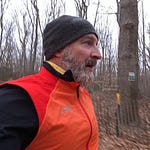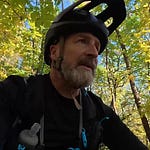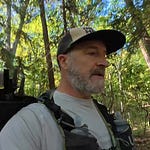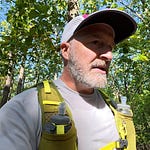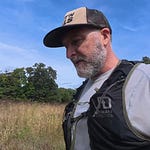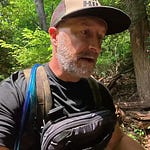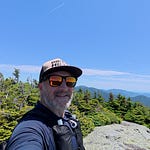Mission Brief: Three weeks ago, the plan was simple: tackle the Allegheny 100 in segments. 25 miles, sleep, 50 miles, sleep, 25 miles. Clean math, manageable chunks. Parking lot conversations with veteran hikers shifted that strategy entirely—push through the night, and sleep during warm daylight hours. Less gear, more efficiency. By start time, I'd committed to the full 100 miles without planned overnight stops.
Trail Conditions: Challenging
Miles 1-10: Fast start. Nearly four mph walking pace in single-file traffic that moved surprisingly well. First 5K at 54 minutes—aggressive but sustainable with a 10-mile interval strategy set on the watch.
Miles 10-25: Partnered with Chris, a serious hiker, and set a good pace. Then the weather moved in. Heavy rain for an extended period—could have been 30 minutes, could have been two hours. Time distorts when you're getting hammered in dark woods.
Miles 25-48: The trail deteriorated significantly. Multiple bridge failures, but one is completely gone. Minister Creek crossing required—knee-deep water at 3 AM. Two-mile descent became a river system punctuated by standing pools. Met up with Shawn, an experienced hiker who had done the event twice before, for the final 15 miles. Navigation is easier with local knowledge.
Objective Reassessment
Original Goal: 100 miles in under 50 hours
Revised Goal: 50-mile in a single push (redemption for the 50-mile ultra in May)
Reality: 48 miles in 15:14
Night hiking assessment: not enjoyable. Would rather sleep like normal people. The challenge was completed, but this specific suffering doesn't align with what I value about time in the woods.
Gear Performance Review
Footwear: Altra Olympus 6 with Injinji toe socks plus compression layer. Loosened lacing for dual-sock setup. Drainage is adequate for sustained wet conditions. Minor blistering—right foot pad, left toe—manageable for distance covered.
Load: 16-17 pounds total. Water, camera, batteries, three days of food. Manageable for hiking, would require a different approach for running.
Today's Pack Test: Durston Kakwa 40 showing promise. Load lifters and hip belts distribute 30 pounds effectively. No shoulder pressure six miles in. Water bottle accessibility significantly improved over Zerk models—can actually reach bottles without contortion.
Problem Areas: Outdoor Vital shorts failing. The waistband can't handle pack movement plus body movement in humid conditions. Reverting to Path Projects for East Coast hiking.
System Notes
Water bottle rotation works as a happy accident—easier rear placement naturally alternates electrolytes and water. Hip belt storage is unused today except for my camera, but real utility for snacks and quick-access items.
Weighted vest placement creates a sagging pack profile. May be contributing to shorts displacement. Better weight distribution is needed for training efforts.
Conditions Assessment
Light rain developing despite a 0% forecast. Thunderstorms are building but not soaking yet. No rain gear carried—calculated risk for the 10-mile distance.
Pack held up through the weather. Minor adjustments are needed as weight settles and comfort preferences emerge, but overall positive first impression.
Performance Metrics
Today's Test
Distance: 10 miles
Time: 3:03
Pace: 18:18/mile
Load: 30 pounds
Allegheny 100 Data
Distance: 48 miles
Time: 15:14
Pace: 19:01/mile
Load: 16-17 pounds
Conditions: Wet, night navigation, infrastructure failures
Assessment
Would repeat Allegheny 100: No. Not due to difficulty, but challenge type mismatch with personal preferences. Possible interest in the 100-mile ultra format, but self-support requirements would need complete strategy revision.
Pack recommendation: Durston Kakwa 40 shows strong performance for load-carrying applications. Access, comfort, and weight distribution are all improvements over previous systems.
Training value: Understanding personal limits and preferences worth more than arbitrary distance completion. Sometimes the best data comes from knowing when to stop.




